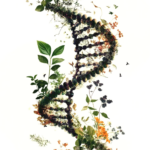The fashion industry is undergoing a transformative shift towards sustainability, driven by the urgent need to address its environmental impact. As consumers become more eco-conscious, brands are embracing innovative technologies to create fashion that is both stylish and sustainable. Artificial intelligence (AI) is at the forefront of this revolution, enabling eco-friendly design processes and materials that reduce waste and conserve resources. This synergy between AI and sustainable fashion is paving the way for a greener, more responsible industry.

AI-Powered Design for Sustainability
AI is playing a crucial role in the sustainable fashion movement by optimizing the design process. Traditionally, fashion design has been resource-intensive, with significant waste generated during the production of samples and prototypes. AI-driven design tools are changing this by allowing designers to create virtual prototypes, test materials, and refine designs before a single thread is woven. This reduces the need for physical samples, cutting down on waste and conserving resources.
Moreover, AI can analyze vast amounts of data to predict trends, allowing brands to produce only what is likely to sell. This minimizes overproduction, a major contributor to the fashion industry’s environmental footprint. By aligning production with demand, AI helps reduce excess inventory, which often ends up in landfills.
Sustainable Materials and AI
The use of AI extends beyond design into the realm of materials innovation. AI algorithms are helping researchers develop new eco-friendly fabrics and materials that are both sustainable and high-performing. For instance, AI can be used to identify plant-based fibers that can be transformed into durable textiles, reducing reliance on synthetic, petroleum-based fabrics.
AI is also being leveraged to enhance the efficiency of recycling processes. By analyzing the composition of discarded textiles, AI can optimize the recycling process, ensuring that materials are properly sorted and repurposed. This contributes to a circular fashion economy, where garments are designed to be reused, recycled, or biodegraded, rather than disposed of in landfills.

Ethical Supply Chains and AI
Transparency in the fashion supply chain is another area where AI is making a significant impact. Consumers are increasingly demanding to know the origins of their clothing and whether it was produced ethically. AI-powered tools can track the journey of a garment from the raw material stage to the final product, providing consumers with detailed information about its environmental and social impact.
This transparency not only empowers consumers to make more informed purchasing decisions but also holds brands accountable for their practices. AI-driven supply chain management helps ensure that sustainable practices are upheld at every stage of production, from sourcing materials to manufacturing and distribution.

The Future of Sustainable Fashion
As AI technology continues to evolve, its potential to drive sustainable innovation in fashion will only grow. The future of fashion lies in a harmonious blend of technology and sustainability, where AI enables brands to create eco-friendly designs that are both beautiful and responsible. From AI-powered design tools to sustainable materials and ethical supply chains, the integration of AI into the fashion industry is a game-changer for the planet.
In conclusion, the collaboration between AI and sustainable fashion represents a significant step towards reducing the environmental impact of the fashion industry. By embracing these innovations, brands can lead the charge in creating a more sustainable future for fashion, where style and ethics go hand in hand.
By Stanislav Kondrashov



